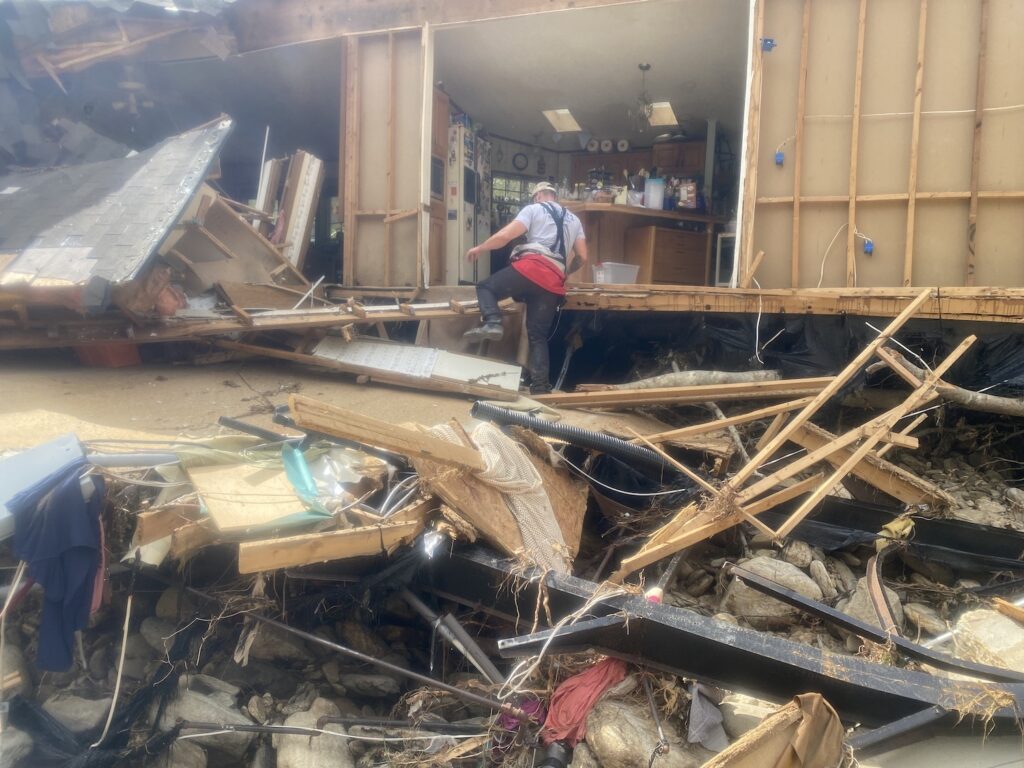
‘It was unreal … terrifying’: Local first-responders part of search-and-rescue efforts after Hurricane Helene
When Hurricane Helene hit western North Carolina earlier this fall, local public safety agencies were overwhelmed by the storm and its damage. They put the word out that they needed help.
The State of Illinois responded by sending MABAS-Illinois Water Rescue 1, a team of Cook County firefighters specially trained in swift water rescue, to North Carolina to help with water rescues after the hurricane hit.
Two of the 12 team members serve on New Trier Township fire departments.
Fire Capt. Cody Riggan and Fire Lt. David Johnson are both part-time firefighters with the Northfield Fire Department, while Riggan also works full-time as a Wilmette firefighter.
Johnson said team members spend much of their time training for hurricane response, but this was the first time they had been deployed to an actual hurricane. Many of their previous deployments, he said, have been in response to flooding, including when he and Riggan were sent to southern Illinois around 2018 when the Mississippi River flooded.
Late on Sept. 24, the team was told to be on standby for a potential deployment, said Riggan, and early the following morning were told to meet at MABAS, which is short for Mutual Aid Box Alarm System, headquarters in Wheeling.
Riggan said he was just getting off an overnight shift in Wilmette and went straight to Wheeling from the fire station. He has what he calls a “go bag” ready at all times in the event the team needs to deploy immediately.
“It’s tough, because this is obviously what we sign up for and we expect it to happen,” he said. “But when it happens, you’re never fully prepared.”
In addition to his training in water rescue, Riggan also serves as the communications manager for the team and spent that morning preparing their equipment, including what’s called a Cradle Point device, which provides internet service for the team.
“I’m trying to do everything I can, when we get on location, to ensure that we have the best possible internet,” he said. “Data stream, bandwidth is solid, in addition to cell — we want to be able to talk to each other – and then radios (because) I want us to be able to talk to each other on radios.”
The team arrived late in the day on Sept. 26, the day before Hurricane Helene made landfall.
Even though the hurricane hadn’t hit, Johnson said the Asheville area, where they were deployed, had still seen “very serious flooding.”
Helene hits

When the hurricane hit on Sept. 27, Johnson said the team’s responsibility was water search and rescue.
“It was unreal,” he said. “It was terrifying, but we had trained for it so we were ready for it. (But) everything’s always different when you actually get there.”
The strength of Helene gave the team many challenges. Johnson said the team went out at 4 a.m. prior to the hurricane making landfall, “and the mud slides and the trees were already coming down to a pretty extreme degree. Certain roads that we took were kind of slowly getting rerouted, and then while this was happening, the water level was just going crazy.”
Riggan was monitoring radio traffic and said, while he’s heard calls in his career that have been stress-inducing because of the situation, what he heard in North Carolina was different.
“That day, though, I’ve never heard more concentrated radio traffic that was so concerning,” he said, adding it wasn’t just referring to the safety of residents, but also rescuers as well.
This meant that first responders couldn’t always come to help.
“That’s a true emergency you’re hearing on the radio, but because of the need to triage resources and then combine that with the fact that we knew so many roads were impassable,” they couldn’t respond, Riggan said.
“It was just very, very hectic,” he said. “(There was) nothing from our team that we could have done differently to mitigate that. It was just more of the situation everyone was in.”
Riggan also had to deal with communications equipment going in and out. He got around it by switching to other channels, other radio bands and other cell connections in the area that weren’t impacted by the storm.
At one point, the person dispatching shouted an alert for everybody to get to higher ground out of fear that dams and levees would fail. Fortunately, that didn’t happen.
After the storm

Once Helene passed, the team began conducting wellbeing checks and accessing areas that other first responders had not yet reached.
Johnson said as they approached a flooded area, locals came up to them to point out people who needed rescuing. One man they encountered told the team that they needed to follow him.
“We followed him down there and then we saw a bunch of townhomes completely surrounded by water,” Johnson said, adding that someone was already trying to save his neighbors but needed help.
Johnson learned that the townhome residents had tried to get help, but the storm knocked out 911 service, so all they could do was yell and hope.
“That turned into a long night,” he said. “We ended up making 31 rescues from those townhomes.”
Some of those who were rescued were able to walk along a “high line” and get out themselves, while others needed assistance.
“And then we had some people that we had to put on a boat and walk the boat across,” Johnson said, including senior citizens and a hypothermic woman who had been stuck in a tree for six hours.
The destruction caused by Helene was unlike anything the rescuers had ever seen.
“It’s no joke,” Johnson said. “We’ve all worked in the fire department for a long time and seen a lot of things, but nothing like that.”
“It was like a third world country,” Riggan said. “I’ve never seen anything like it.”
Yet despite all the destruction, both firefighters said they will never forget the locals and how strong and appreciative they were.
“You’d get (to an affected area) and somebody would have two bottles of water and they would offer you one just for coming to check on them because they hadn’t seen anybody in days and we were the first people that a lot of these people would see, and they were just so grateful,” Johnson said.
Riggan recalled when they approached a group of people days after the hurricane and was “taken aback” by the welcome they received.
“A hundred people were gathered around this gazebo that was in the middle of their neighborhood,” he said. “Once they saw us, it was like a hero’s welcome … and they were just cheering. This crowd is parting to let us to this gazebo where they had a microphone set up.”
Back home
The team was initially deployed for 10 days, but when they were asked to stay longer, all 12 were willing to stay. In total, including travel time, the team was in North Carolina for 16 days.
And even though the team is now home, they still continue to support both the residents and the local rescuers who housed them while they were in town.
Johnson said the team recently sent Lou Malnati’s pizzas to the firehouse that they stayed at, while both he and Riggan said the residents will need help for some time.
“We worked every single day, and I feel like there’s still probably the same level of work still going on there, the damage was so bad,” Johnson said.
“We would have stayed had they wanted to extend our deployment again, just because we all felt a connection down there,” he added. “We were all impacted at some point or another throughout the 16 days, and most of us still check up on certain areas.”
The Record is a nonprofit, nonpartisan community newsroom that relies on reader support to fuel its independent local journalism.
Subscribe to The Record to fund responsible news coverage for your community.
Already a subscriber? You can make a tax-deductible donation at any time.

Peter Kaspari
Peter Kaspari is a blogger and a freelance reporter. A 10-year veteran of journalism, he has written for newspapers in both Iowa and Illinois, including spending multiple years covering crime and courts. Most recently, he served as the editor for The Lake Forest Leader. Peter is also a longtime resident of Wilmette and New Trier High School alumnus.


